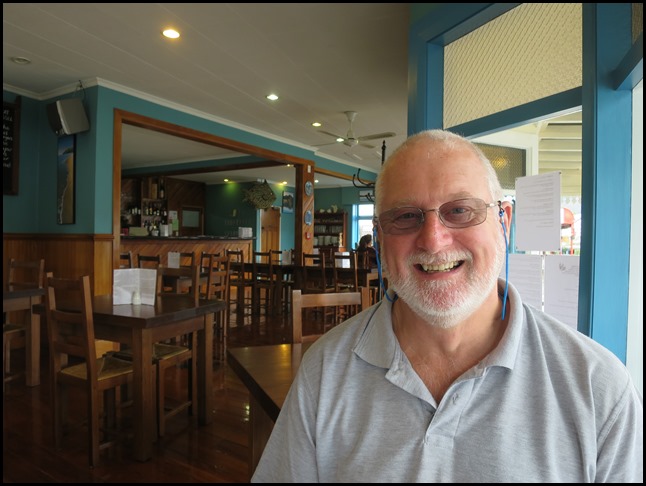Mussels

Beez Neez now Chy Whella
Big Bear and Pepe Millard
Thu 18 Sep 2014 22:47
|
Mussels in the Mussel Capital
of the World
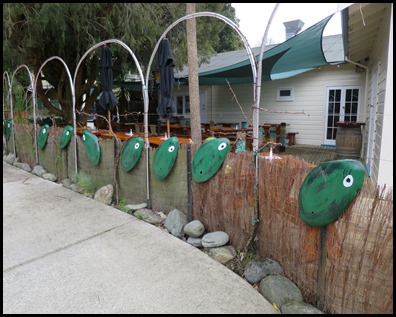  To eat a plateful of mussels in
Havelock the greenshell capital of the world, was a must-do for Bear. His bucket
list, his choice of eatery. We parked Mabel just off the main road and bimbled
across to the Mussel Pot. The fence looked like fun
and then two chaps welcomed us at the front door.
 First fancying mussel chowder, Bear
chose mussels with blue cheese.
Mussels have always been regarded as
a fantastic food, not by me however. The look, texture and smell make them far
from anything I have ever deemed a life necessity to try and nary one has ever
got close to my lips, but Bear loves them. I don’t mind preparing them for him
and cook them in a variety of ways. The same goes for all things shellfish, to
watch someone swallow a raw oyster, as far as I’m concerned, pushes the vows of
marriage to their extreme limit, why not cut a flip-flop up into similar sized
portions and soak them in fish gravy, but there we are, each to his own.
Traditionally harvested from the
shoreline by local and visiting Māori, Marlborough mussels were a drawcard for
North Island Māori who would launch expeditions to gather kai moana, food of the
sea, as well as locals who would gather regularly to supplement their diet.
In 1969 a group of fishermen towed the first mussel
barge into the Marlborough Sounds and anchored it in the Kenepuru. In the past
forty-odd years since, the New Zealand aquaculture industry has evolved from a
group of innovative pioneers to a professional, specialised and premium food
production sector focused on environmental sustainability, food safety and
value-added marketing. Most farms
were originally started by independent farmers but today there is an increasing
trend for sites to be owned by seafood companies. First attempts to farm mussels were based on Spanish raft cultivation
techniques. There were superseded by the Japanese longline system which has been
adapted and improved by New Zealand operators.
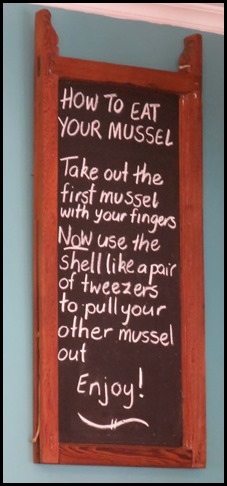 In 2011 the
industry employed over three thousand New Zealanders and generated over $400
million of revenue. Of the $400 million industry revenue, $298 million was
generated in exports. Aquaculture
is already the world’s fastest growing primary industry and demand for
aquaculture products is expected to strengthen significantly as the world’s
population grows and wild-catch levels remain relatively static.
New Zealand
aquaculture products are exported to seventy nine countries and considered among
the world’s best seafood, served at parties in New York and white tablecloth
restaurants in London. The high
quality of New Zealand coastal waters and the abundance of plankton, along with
the prevalence of sheltered harbours and inlets create ideal conditions for
aquaculture.
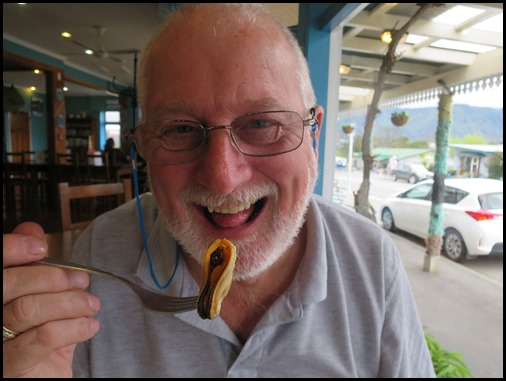 Time to get my head down to the
business of concentrating on my fish and chips as the eating
begins.........
The New Zealand green-lipped mussel,
Perna canalicula, is endemic to New Zealand. When grown for aquiculture in New
Zealand it is produced under the trademark name Greenshell. The bulk of the
industry’s spat – baby mussels, are gathered on ninety mile beach where,
considerable quantities of new settled spat attached to seaweed are washed up on
the beaches. This spat is collected and quickly transported by air or truck to
growers in other parts of the country. local spat catching also occurs in Golden
Bay and Marlborough in selected bays. The spat is seeded out on spat ropes using
cotton stocking at approximately one to five thousand per metre of rope. After
three to six months, the nursery lines are lifted and the young spat are
stripped from the ropes and reseeded on a final production rope at approximately
one hundred and fifty to two hundred per metre. The mussel has a foot –
sometimes called a tongue, which allows it to move over surfaces. Once the
mussel finds a suitable site, fluid is shot down a groove in the foot and
solidifies on contact with the sea water, anchoring the mussel in place. Mussels
take between fifteen and eighteen months to grow to a shell size of seventy to a
hundred millimetres.
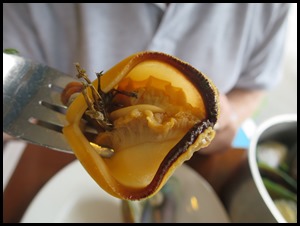 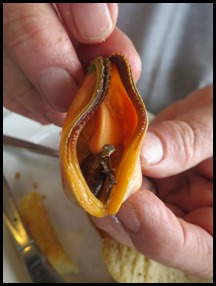  Silly me, I ask for a closer look.
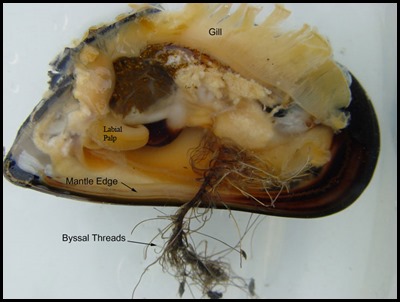 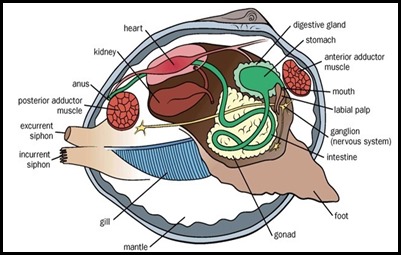 Suddenly interested I ask Bear about his experience with byssal threads. You can’t
taste anything an they are not stringy which I thought they might be, but
chewing the whole thing there are lots of textures. Oooo, perhaps too much information, I swallow and duck to my side
salad. An interesting thing I did read, here in the
restaurant, they don’t automatically throw away a shell that has stayed shut,
neither have I. I have always opened and sniffed. Its all to do with what
happens to the adductor muscle of the mussel I say knowledgably to himself, some
disintegrate completely in hot water, some fall off one side. Oh, its a muscle is it, I didn’t know that, never tried it
before. What did I say, silly me, next thing he’s prising one off to
taste, well. Tastes like squid and chewy, not easy to
get off though. Oh dear, have I got to try not to watch as he
rummages through his empty shells thus far and eat those he hasn’t got to yet.
Yep.
The diet of a mussel includes single
cell algae and planktonic animals. Mussels are filter feeders and each mussel is
capable of filtering about three hundred litres of water per day. With
approximately nine hundred million mussels grown commercially in Marlborough
Sound, this means a massive two hundred and seventy million tonnes of water is
moved by mussels every day. The single biggest factor that can affect the water
quality is the land run-off as a result of rainfall. A number of rain gauges are
positioned throughout the mussel farm areas which are monitored by the New
Zealand Food Safety Authority. The data collected determines which farms are
open or closed for harvesting. The New Zealand mussel industry is known to
operate one of the strictest quality assurance programmes in the
world.
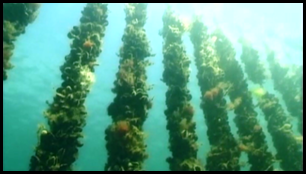 When the mussel farm is declared
open, a harvesting boat will select a designated line and hauls on board the
rope that is fully laden with mussels. The mussels are removed from the rope and
are then de-clumped and washed. The mussels will go through a quick initial
grading and are then collected into large bags for transporting. A single
harvester will typically collect between fifty and seventy tonnes of mussels
each day. The flow of mussels through the processing chain is rapid. The bulk of
production takes less than thirty minutes from the beginning of the cycle to the
final packaging for domestic or international distribution. Mussels are processed into many product
forms including live, chilled, vacuum packed, frozen whole or half shell, layer
packed meat, smoked marinated, crumbed, powdered, dried and stuffed. When the mussels arrive at The Mussel Pot they are checked to
ensure all are alive and in good condition. The beards are trimmed purely for
aesthetic purposes. The chef does not rip the beard out, as this kills the
mussel. Well over half the local mussels contain the New Zealand pea crab.
Current research is being done on the effects of the pea crab on the growth and
ways to eliminate them from mussel farms. The Mussel Pot
do not add salt to their mussels, they are naturally salty as they are so fresh
and have not been constantly washed with fresh
water.
  The different
sexes of mussels can be identified by their colour, I asked
Bear to tidy his chosen chap up for a photograph. The flesh of a sexually mature male is creamy white while a female is
reddish-apricot. Reproduction
between male and female mussels happens outside the shell. Eggs and sperm are
discharged into the water and fertilisation takes place. Most spawning occurs in
late spring and early autumn but mussels have been known to be opportunistic and
take advantage of favourable conditions of plentiful food and ideal
temperatures.
 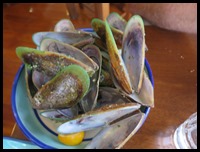 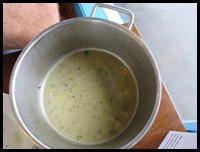 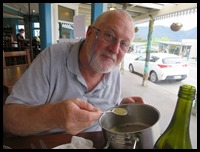 At last, to my relief I thought the
empty plate, the pile of empty
shells meant I could return to normal life, no Bear saw the juice in the bottom of his pot and set about it with great gusto. I went back to busying
myself reading the factoids.
ALL IN ALL NOT FOR
ME
YES
PLEASE |
